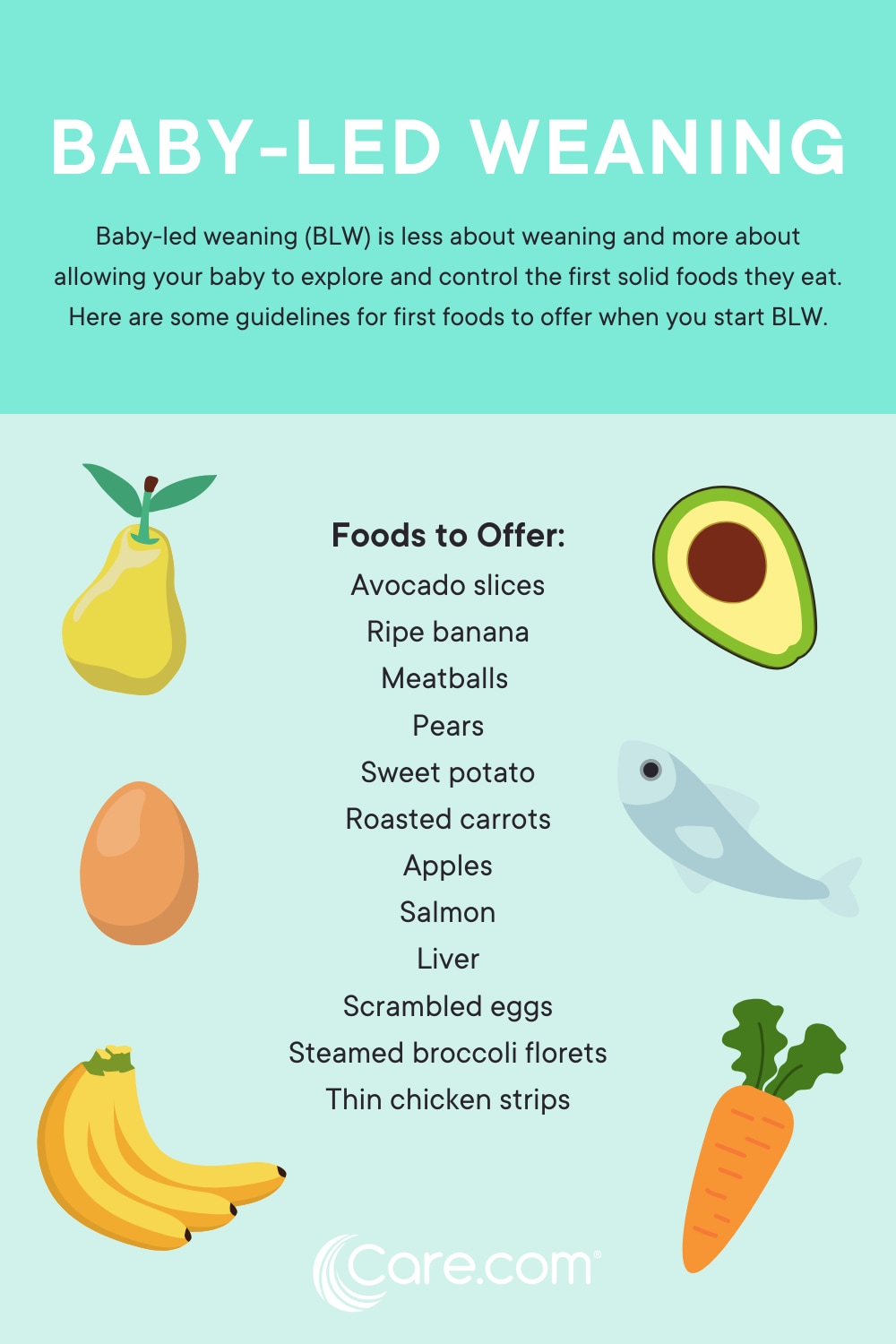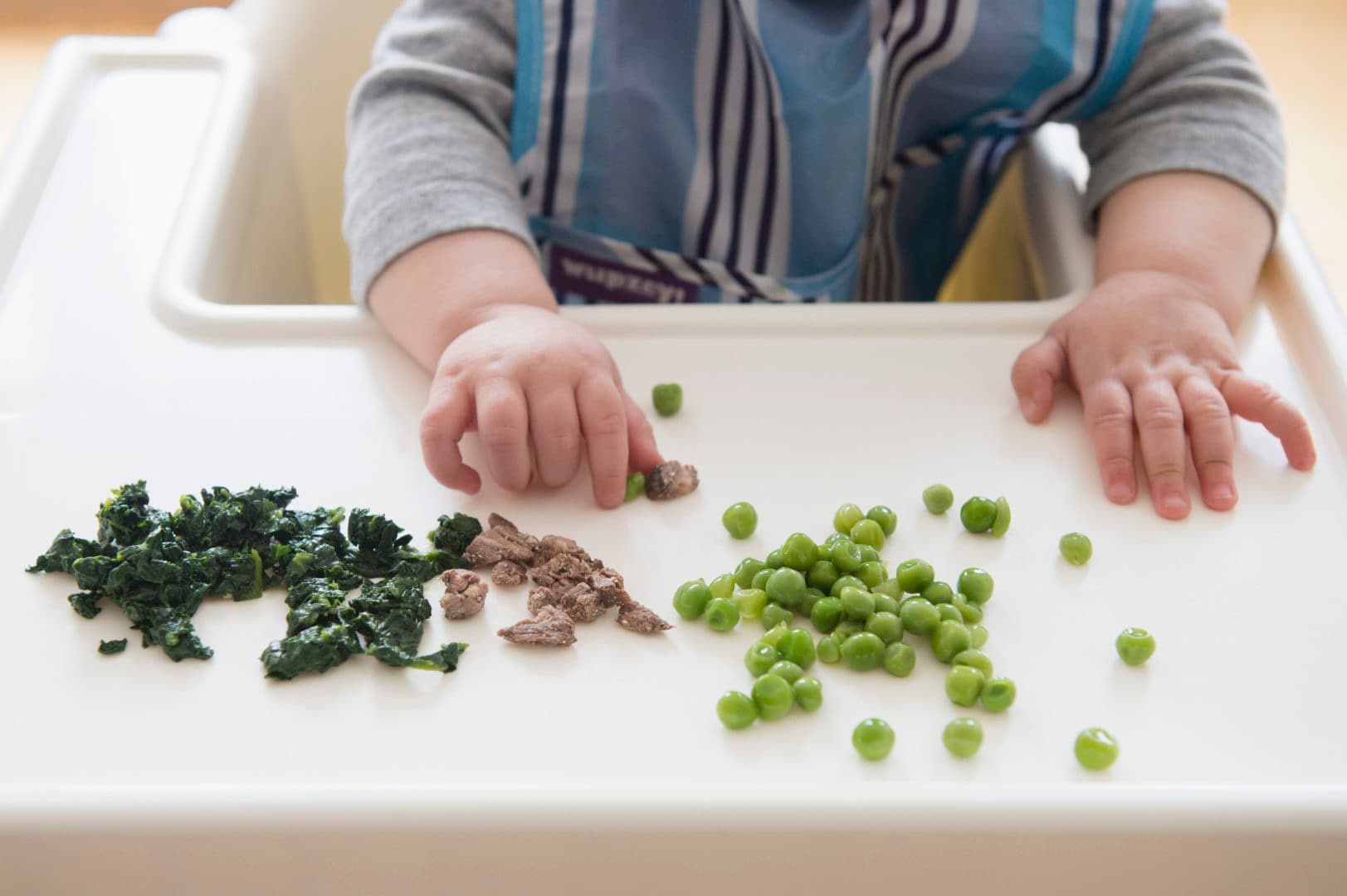If your little one has started taking a serious interest in your spaghetti bolognese, it may be time for that wonderfully messy milestone in eating: baby-led weaning. Traditionally, parents have been advised to start their baby off with instant rice cereal or jars of pureéd squash, but today, many families are practicing baby-led weaning by introducing a variety of solid foods and helping infants learn to feed themselves.
Interested in trying baby-led weaning (BLW) but feel a little unclear on the process? Here, experts break down everything parents need to know about this less conventional way of introducing complementary foods. Bon appétit!
What is baby-led weaning?
“Baby-led weaning is a method of introducing complementary foods to baby using real foods the rest of the family is eating, rather than starting with single ingredient cereals or purées,” says Laura Morton, a registered dietician and author of “BLW Baby Food Cookbook: A Stage-by-Stage Approach to Baby-Led Weaning with Confidence.” “With baby-led weaning, babies feed themselves [with their hands], guided by their own feelings of hunger and fullness.”
According to Morton, baby-led weaning is a “back to basics” approach to feeding baby.
“From jars and pouches of purees to special meals and drinks just for kids, the baby and toddler food industry has changed how babies eat in the last 50 years,” Morton says. “With baby-led weaning, there are no special meals just for baby, but rather a focus on eating whole, unprocessed foods together as a family.”
What age can you start baby-led weaning?
Around the age of 6 months, most babies will be ready for solids — pureés or foods introduced via baby-led weaning, according to Dr. Brandon Smith, general academic pediatrics fellow in the Department of Pediatrics at Johns Hopkins in Baltimore.
“Some babies may need a little more time if they’re still working on their head support or if they’re still mastering how to hold things in their hands,” says Smith. “But as long as they’re age and developmentally ready, it’s OK to see if they’re interested in food other than breast milk and formula — just don’t force it. Letting them lead the way is a major aspect of baby-led weaning.”
No matter when you decide to try baby-led weaning, keep in mind that breast milk or formula should remain the primary source of nutrition for your baby the first six months and a major source throughout the first year (amounts vary according to weight), according to the American Academy of Pediatrics (AAP).
“Baby-led weaning can be a confusing term because it’s less about weaning and more about introducing solid foods to your infant,” Smith says. “It’s the idea that babies should be allowed to explore and control the solid foods they are first given to eat.”
How do I know if baby is ready for baby-led weaning?
When it comes to determining if your little one is ready for baby-led weaning, take their development, more than their age, into account.
“Babies need to hold their head upright and sit without any support to safely eat solid foods, whether that’s through baby-led weaning or the traditional way of introducing solids,” says Smith. “They should also be able to grasp things in their hands to hold and bring to their mouth.”
In addition to being able to meet these developmental milestones, pay attention to what piques your little one’s interest, advises Diane Spatz, a professor at the University of Pennsylvania School of Nursing and nurse scientist for the lactation program at Children’s Hospital of Philadelphia.
“A good sign baby is ready to start baby-led weaning is if they’re showing an interest in what you’re eating while showing the feeding cues of putting their hand to their mouth,” says Spatz.
Staring or reaching for your food are good indicators that your little one has taken an interest in what you’re eating.
How do I start baby-led weaning?
Once everyone is ready to try baby-led weaning, there are a few things you can do to help make it a pleasant (and successful!) experience.
Let them watch. Morton recommends a period of observation for baby.
“A good way to start the process is to include baby in some family meals before they are able to join in the actual eating,” says Morton. “Babies learn so much by watching us eat.”
Feed first. When your baby first begins exploring solids, give them a little breast milk or formula prior to offering solid food in order to keep them from getting hangry.
“In those early weeks, learning to self-feed can be frustrating if baby comes to the table too hungry,” says Morton. “As baby becomes a little more efficient at eating, breast or bottle feeding before meals isn’t as important.”
Soften food, if necessary. “If you’re serving baby harder fruits and vegetables, such as apple or pears chunks, they need to be softened beforehand so that they can be mashed between the tongue and roof of baby’s mouth,” says Smith.
A general rule of thumb: If a food can be mashed between your fingers, it can be mashed between baby’s gums, Smith says.
Steer clear of small, hard pieces. “Never offer anything that can come off in pieces or crumbs and definitely no grapes, nuts or other small foods that may cause the baby to gag or choke,” says Smith.
Let them explore (and make a mess!) Once you think your baby is ready, allow them to explore a variety of soft foods that are easy to grasp.
“Try cutting a banana in half and peel it down a little bit so baby can touch, hold and chew it,” says Smith. “It’s not about nutrition right away. It’s more about the introduction of foods and showing them a variety of foods, as they move away from breast milk or formula.”
Cut food up. “Before serving baby food, it’s best to cut it up into thin, finger-length strips, which makes it easier for baby to grasp and successfully bring to their mouth,” says Morton.
Serve, don’t push. One of the main goals of baby-led weaning is to teach baby to self-regulate their food intake — so let them do just that.
“It’s the parent’s job is to decide what food to offer, when to offer it and where it will be served,” says Morton. “It’s the baby’s job to decide whether — and how much — they’ll eat. By taking this approach, you’re encouraging baby to enjoy a healthy relationship with food.”
Give it time. If at first you don’t succeed with baby-led weaning, try, try again. Eventually, your child will get the hang of things — and remember, a key of baby-led weaning is letting baby go at their own pace.
“It’s almost always going to take a few days for a baby to get used to a new food or new way of eating,” says Spatz. “So, if they don’t take to it the first time, try again. Also, don’t stress too much about things — including the mess they’ll inevitably make. This should be a fun time of exploration for both you and your child.”
What are the pros of baby-led weaning?
From encouraging family dinnertime to helping children maintain a healthy weight, there are a number of benefits to baby-led weaning.
It can prevent picky eating. “Since babies are being offered table foods right from the start with baby-led weaning, they may wind up being less picky eaters and be more OK with a variety of textures,” says Smith.
It can save time and money. “A great thing about baby-led weaning is that parents have to do no extra work or spend extra money,” notes Spatz. “Baby food can be incredibly expensive!”
(Note: Parents can do both baby-led weaning solids and pureés, if they’d like. It doesn’t have to be one or the other.)
It encourages family meal times. Since everyone is eating the same thing, families who are practicing baby-led weaning often eat together, without mom or dad having to spoon mashed peas into baby’s mouth in between bites. Family meals have been proven to have a number of benefits for children, including higher self-esteem and better academic performance.
It can promote a healthy relationship with food. “Baby-led weaning, as a concept, gives babies the chance to have control over their feeding from the start,” says Smith. “This can be helpful for them to learn when they are hungry and when they are full and may help to control weight gain throughout childhood.”
What are the cons of baby-led weaning?
While the benefits of baby-led weaning are plentiful, there also are drawbacks that shouldn’t be taken lightly.
It may require more cooking. If your family has a tendency to dine out often or eat pre-packaged foods, you may wind up cooking or preparing more.
“A certain level of home cooking is required for baby-led weaning,” says Morton. “Processed, pre-packaged foods and restaurant meals are very often too high in both sodium and added sugars for baby.”
There’s a risk of choking. “The biggest worry about baby-led weaning, and one that parents should be aware of, is the risk of choking,” says Smith. “Baby-led weaning gives babies harder pieces of solid foods sooner, which have a bigger choking risk than the purees usually offered first.”
Keep reading for tips and ideas for foods that pose less risk for choking.
Is baby-led weaning dangerous?
Whether you’re introducing complementary foods via baby-led weaning, pureés or a combination of both, it’s important to be vigilant when your baby is eating.
“Parents should always be aware of what foods they’re offering and if that food has a choking risk,” says Smith. “And they should always be watching their child when they are eating.”
According to the National Library of Medicine, the following are signs baby is choking:
- Bluish skin color.
- Difficulty breathing (ribs and chest pull inward).
- Loss of consciousness.
- Inability to cry or make noise.
- Weak coughing.
- Soft or high-pitched sounds while inhaling.
Before starting solid food of any type, speak with your pediatrician about what to do in a choking emergency.
What foods do you start with for baby-led weaning?
In the past, parents were advised to start baby off with a single-grain cereal, but then the AAP began to get more lax with its complementary food guidelines. They now say, “Your baby’s first foods are your choice” so long as they’re soft or pureed to avoid choking risks. They also recommend introducing a “single-ingredient” new food from any food group every three to five days and watching out for any reactions.
According to Morton and Smith, the following easy-to-grip, easy-to-gum nutritious foods are great for baby-led weaning:
- Avocado slices.
- Ripe banana.
- Sweet potatoes.
- Roasted carrots.
- Meatballs.
- Pears.
- Apples.
- Salmon.
- Liver.
- Scrambled eggs.
- Steamed broccoli florets.
- Thin chicken strips.

If you’re looking for baby-led weaning recipes to serve your little gourmand, Morton recommends combining foods that touch on key nutrients like iron and healthy fats.
“A favorite of mine is ripe avocado slices with tender, slow-cooked chicken or mashed lentils,” she says.




